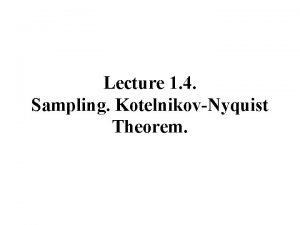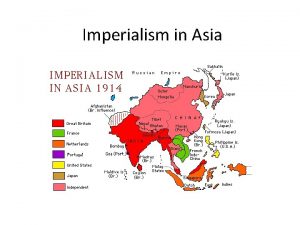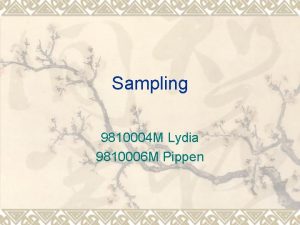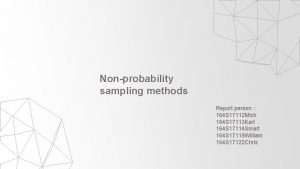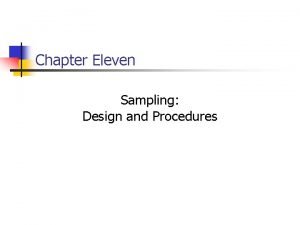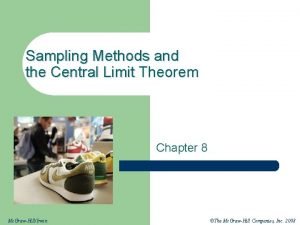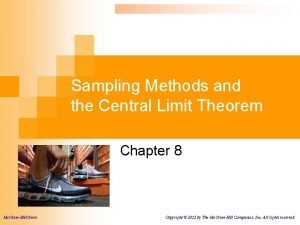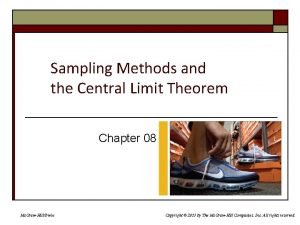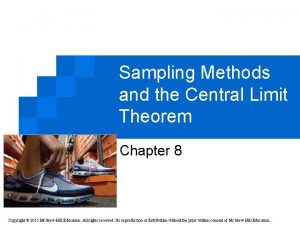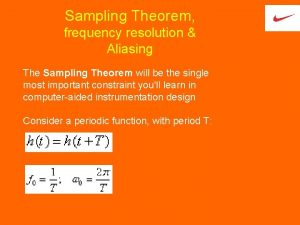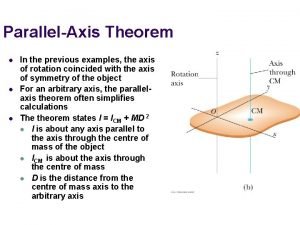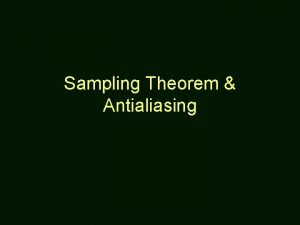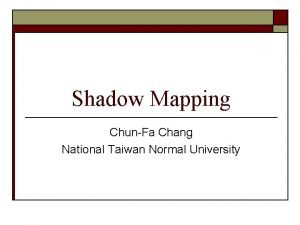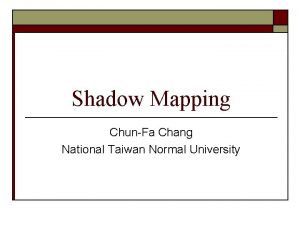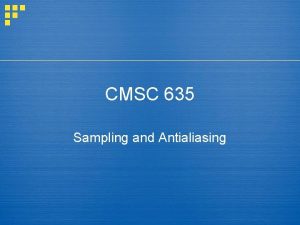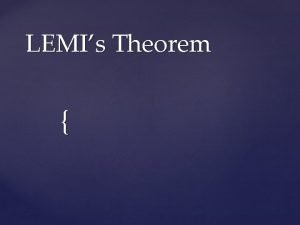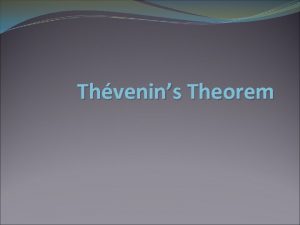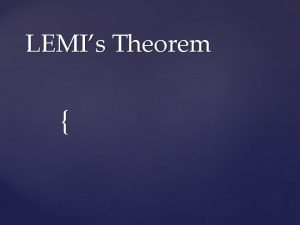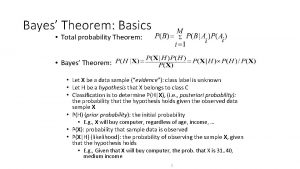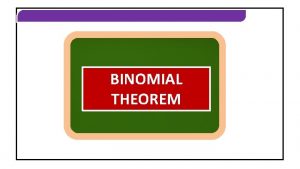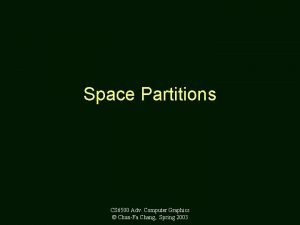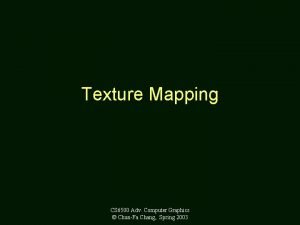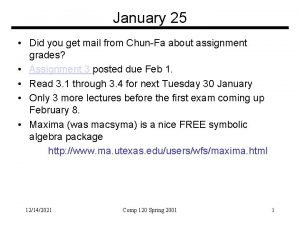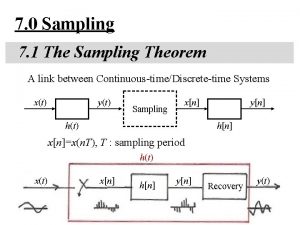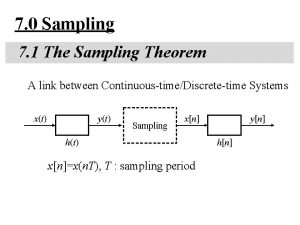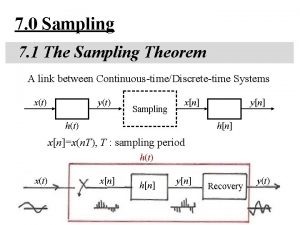Sampling Theorem Antialiasing ChunFa Chang Motivations My images










![Basis Functions • An example: X=[x 1, x 2, …, xn] U=[u 1, u Basis Functions • An example: X=[x 1, x 2, …, xn] U=[u 1, u](https://slidetodoc.com/presentation_image_h2/afac3369b6618a65a5c6782a3941355c/image-11.jpg)






















- Slides: 33

Sampling Theorem & Antialiasing © Chun-Fa Chang

Motivations • “My images have a lot more pixels than the TV screen. Why do they look like @#$%? ” • How to compute the pixel colors for the following pattern? Antialiasing with Line Samples Rendering Techniques '00 (Proceedings of the 11 th Eurographics Workshop on Rendering), pp. 197 -205 Thouis R. Jones, Ronald N. Perry © Chun-Fa Chang

Part I: Sampling Theorem © Chun-Fa Chang

Example of Aliasing in Computer Graphics © Chun-Fa Chang

Examples of Aliasing in 1 D • See Figure 14. 2 (p. 394) of Watt’s book for other examples. © Chun-Fa Chang

An Intuition – Using a Single Frequency • It’s easy to figure out for a sin wave. • What about any signal (usually a mixture of multiple frequencies)? • Enter Fourier Transform… © Chun-Fa Chang

Sampling • 1 D Signal: x f(x) becomes i f(i) • 2 D Image: x, y f(x, y) – For grayscale image, f(x, y) is the intensity of pixel at (x, y). © Chun-Fa Chang

Reconstruction • If the samples are “dense” enough, then we can recover the original signal. • Question is: How dense is enough? © Chun-Fa Chang

Fourier Transform • Can we separate signal into a set of signals of single frequencies? w t w © Chun-Fa Chang

Square Wave • Even a square-shape wave can be represented by the sum of a series of sin or cos functions • See – https: //bl. ocks. org/jinroh/7524988 – https: //youtu. be/Lznj. C 4 Lo 7 l. E – http: //blog. xuite. net/lapuda. chen/Paul. Blog/ 221866406 © Chun-Fa Chang
![Basis Functions An example Xx 1 x 2 xn Uu 1 u Basis Functions • An example: X=[x 1, x 2, …, xn] U=[u 1, u](https://slidetodoc.com/presentation_image_h2/afac3369b6618a65a5c6782a3941355c/image-11.jpg)
Basis Functions • An example: X=[x 1, x 2, …, xn] U=[u 1, u 2, …, un] V=[v 1, v 2, …, vn] Let X = a*U + b*V, how to find a and b? • If U and V are orthogonal, then a and b are the projection of X onto U and V. © Chun-Fa Chang

Compared to Fourier Transform • Consider a continuous signal as a infinitedimensional vector [ f(e), f(2 e), f(3 e), …. . ] t • Consider each frequency w a basis, then F(w) is the projection of f(x) onto that basis. © Chun-Fa Chang

Sampling • Spatial domain: multiply with a pulse train. • Frequency domain: convolution! © Chun-Fa Chang

Convolution • To start with, image that f(x) is nonzero only in the range of [-a, a]. – Then we only need to consider g(x) in the range of [x-a, x+a] • Multiplication in spatial domain results in convolution in frequency domain (and vice versa). © Chun-Fa Chang

An Intuition for Convolution • Does it make sense to you that multiplication in one domain becomes convolution in the other domain? • Look at this example: • What are the coefficients of P 1*P 2? © Chun-Fa Chang

• Consider xn, …, x 2, x 1, x 0 as basis. • Projections of P 1 and P 2 to the basis are (a 1, b 1, c 1, d 1) and (a 2, b 2, c 2, d 2) • P 1(x)*P 2(x) results in: (a 1, b 1, c 1, d 1) (a 2, b 2, c 2, d 2) in the transformed space. © Chun-Fa Chang

• The fact is: you have been doing convolution since elementary school! • Example: 222*111 is computed as (2, 2, 2) (1, 1, 1) © Chun-Fa Chang

Reconstruction • Frequency domain: • Spatial domain: convolve with Sinc function © Chun-Fa Chang

Reconstruction Kernel • For perfect reconstruction, we need to convolve with the sinc function. – It’s the Fourier transform of the box function. – It has infinite “support” • May be approximated by Gaussian, cubic, or even triangle “tent” function. © Chun-Fa Chang

Nyquist Limit • Nyquist Limit = 2 * max_frequency • Undersampling: sampling below the Nyquist Limit. © Chun-Fa Chang

Part II: Antialiasing © Chun-Fa Chang

Changes within a Pixel • A lot can change within a pixel: – Shading – Edge – Texture • Point sampling at the center often produces undesirable result. © Chun-Fa Chang

Pixel Coverage • What should be the pixel colors for these? • Can we simply use the covered areas of blue and white? (Hint: convolve with box filter. ) • Do we have enough data to compute the coverage? © Chun-Fa Chang

Antialiasing • Consider a ray tracer. Is it often impossible to find the partial coverage of an edge. • Each ray is a point sample. • We may use many samples for each pixel slower performance. © Chun-Fa Chang

Antialiasing – Uniform Sampling • Also called supersampling • Wasteful if not much changes within a pixel. © Chun-Fa Chang

Filtering • How do we reduce Nx. N supersamples into a pixel? – Average? – More weight near the center? • Let’s resort to the sampling theorem. © Chun-Fa Chang

Reconstruction • Frequency domain: • Spatial domain: © Chun-Fa Chang

A Few Observations • In theory, a sample influences not only its pixel, but also every pixels in the image. • What does it mean by removing high frequencies? © Chun-Fa Chang

Other Than Uniform Sampling? • So far, the extra samples are taken uniformly in screen space. • Other ways to take extra samples: – Adaptive sampling – Stochastic (or randomized) sampling © Chun-Fa Chang

Antialiasing – Adaptive Sampling • Feasible in software, but difficult to implement in hardware. • Increase samples only if necessary. • But how do we know when is “necessary”? – Check the neighbors. © Chun-Fa Chang

Antialiasing – Stochastic Sampling • Keep the same number of samples per pixel. • Replace the aliasing effects with noise that is easier to ignore. © Chun-Fa Chang

Mipmap – Antialiasing for Texture Mapping • When we reduce a 2 Nx 2 N texture into a Nx. N texture for the next level of mipmapping, we are doing the filtering (usually by bilinear filtering). • Trilinear filtering: If the most suitable texture is between Nx. N and 2 Nx 2 N, then access texels from both levels, and then interpolate. • Note that the filtering is isotropic (vs. anisotropic), meaning the filtering is done on a square (or a circle). From: http: //commons. wikimedia. org/wiki/File: Mip. Map_Example_STS 101. jpg

Anisotropic Mipmap From: http: //commons. wikimedia. org/wiki/File: Mip. Map_Example_STS 101_Anisotropic. png
 Pygame antialiasing
Pygame antialiasing Mlaa
Mlaa Antialiasing filter
Antialiasing filter Aliasing and antialiasing in computer graphics
Aliasing and antialiasing in computer graphics Green's theorem stokes theorem divergence theorem
Green's theorem stokes theorem divergence theorem Buying motivations
Buying motivations Asia imperialism
Asia imperialism Motivations for imperialism in asia
Motivations for imperialism in asia Motivasi fisik adalah
Motivasi fisik adalah Character traits and motivations
Character traits and motivations What did samuel de champlain accomplish
What did samuel de champlain accomplish John cabot motivations
John cabot motivations God glory gold
God glory gold Imperialism motives
Imperialism motives 3g's of exploration
3g's of exploration English motivations for settlement
English motivations for settlement Sampling method in research
Sampling method in research Objectives of sampling
Objectives of sampling Cluster and stratified sampling
Cluster and stratified sampling Perbedaan event sampling dan time sampling
Perbedaan event sampling dan time sampling Cluster random sampling vs stratified
Cluster random sampling vs stratified Sampling definition in research
Sampling definition in research Natural sampling vs flat top sampling
Natural sampling vs flat top sampling Convenience sampling images
Convenience sampling images Sampling techniques in qualitative research
Sampling techniques in qualitative research Convenience sampling images
Convenience sampling images Convenience sampling images
Convenience sampling images Convenience sampling example
Convenience sampling example Sampling methods and the central limit theorem
Sampling methods and the central limit theorem Sampling methods and the central limit theorem
Sampling methods and the central limit theorem Sampling methods and the central limit theorem
Sampling methods and the central limit theorem 抽樣分配
抽樣分配 Aliasing frequency formula
Aliasing frequency formula Sampling theorem
Sampling theorem


